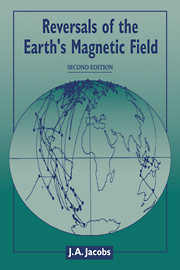Book contents
7 - Magnetostratigraphy
Published online by Cambridge University Press: 23 September 2009
Summary
Introduction
Magnetostratigraphy organizes strata according to their magnetic properties acquired at the time of deposition. Because the polarity of the Earth's magnetic field has reversed repeatedly in the geological past and because polarity transitions, while lasting only a few thousand years, are synchronous over the entire globe, their record in marine or land-based sediments provides isochrons applicable to worldwide correlation. Khramov (1957) recognized the value of palaeomagnetism in the subdivision and correlation of sedimentary sequences in the Soviet Union. However, it was not until it was used in deep-sea sedimentary sequences many years later that the value of magnetic stratigraphy was fully appreciated. Magnetic reversals are distinct from most other stratigraphic criteria, which are characteristically diachronous. There are other synchronous events such as tephra layers which may be used for correlation but which are too restricted geographically for wide-scale use.
Magnetostratigraphy for the last 5 Ma, based on radiometric dating of sequences of terrestrial lava flows, has provided information with which to establish age relationships of sediment and fossil sequences. This chronology in turn has provided a basis for determining rates of geological change with fair accuracy. It must be stressed, however, that a magnetostratigraphic sequence by itself does not provide unequivocal dates for geological events preserved in sediments, since magnetic reversals are repetitive events and do not, in general, possess singular properties. Independent criteria are therefore required to verify the age of a sequence. However, examination of microfossils at only a few stratigraphic levels may enable a biostratigrapher to establish the age of a magnetic polarity sequence.
- Type
- Chapter
- Information
- Reversals of the Earth's Magnetic Field , pp. 226 - 257Publisher: Cambridge University PressPrint publication year: 1994



